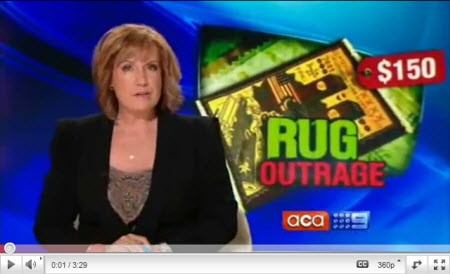Last week loyal ACA viewers were treated to a special investigation. It seems star reporter Damian Murphy had got his mitts on a Afghan “war rug” depicting the September 11 attacks on the Twin Towers and was keen to inflame some public sentiment.
“It’s the imported woven rug that’s got them hopping with rage,” Murphy opened, alongside footage of an irate woman stamping on the rug in Sydney’s Circular Quay, who claimed her “uncle” had been killed in on September 11.
Set against foreboding music strongly resembling the opening bars of Terminator 2, Murphy grimly informed the nation that he was “getting the same response wherever we go”.
“You know that’s how they are…these extremists, but seeing it just makes your hair stand on end,” said one bystander. “It makes my heart beat very fast…I’m sorry I can’t look at it anymore,” added another.
Keen to know more, Murphy traveled to Afghan Nomadic Carpets on Sydney’s North Shore and confronted the sellers of the rug, who couldn’t work out what he was on about.
The rug
In Afghanistan, war rugs have a special place in the country’s centuries old culture as a way for rural peasants to make sense of the country’s daily life. Prior to the Soviet Invasion in the 1979 they often depicted scenes of pastoral bliss, but as chaos reigned their content understandably changed. In the West, these unique documents of collective grief are highly sought after.
Unfortunately, Murphy, who did not respond to a voicemail left on his work number this morning, failed to include that background in his three minute piece, even though he was well aware of it. An amusing email chain, obtained by Crikey, gives an insight into what ACA knew, but chose not to use.
Prior to the story’s broadcast, a former Afghan refugee was contacted by Murphy who wanted him to translate some of the writing on the rugs. Sniffing a beat up, he declined, informing Murphy instead of the rugs’ history.
“Well I got a call from Damian Murphy of A Current Affair,” the correspondent explains.
“And he told me he had an Afghan rug with images of planes hitting the Twin Towers and some writing. He wanted me to translate that. He also said he had been showing the rug at Circular Quay to people and people were getting upset.”
The correspondent informed Murphy that because the writing on the rugs is usually a copy of a copy of a source image, it was an indecipherable mishmash.
“No one knew what the images on the rug meant, whether they were in good or bad taste. He wanted me to appear on camera…to decipher the rug. So I told him to email me the image and I’d have a look but I made it clear I won’t be going on camera for A Current Affair.”
To Murphy’s partial credit, he did manage to include the views of an Afghan art academic who told viewers that in fact the rug was an “expression of hope”, albeit interspersed with footage of the dodgy proprietor. And Islamic Friendship Association president Keysar Trad was also interviewed, but then mocked when he actually attempted to interpret the rug’s message.
The Middle Eastern rug storytelling tradition is extremely popular in the West, with US collectors in particular jumping on board following a number of Los Angeles Times features like this one. World-renowned galleries like the University of Pennsylvania Museum of Archaeology and Anthropology display them. And then there’s Warrug.com, which contains 20 different versions of the Twin Towers rug “exposed” by ACA.
The Sydney Morning Herald had done a good job profiling the owner of Afghan Nomadic Carpets, Mohammad Barez, way back in 2002. The Soviet-era war rugs and their supreme collectability got a special mention.
But for ACA‘s viewers, the woolly picture in this rug beat-up was of Islamic radicals rolling around in America’s misfortune.
“It is easy to see how it will upset some people,” Tracy Grimshaw summarised. But not, perhaps, the people ACA had in mind.










‘… the woolly picture in this rug beat-up was of Islamic radicals rolling around in America’s misfortune.’
It looks like ACA is doing the rolling around.
You have to wonder what sort of reactionary society (“with more stories to cover”?) some of these “media types” are looking to engender, cultivate and nurture – and “why”.
Are they that devoid of forethought, that they can’t see any repercussions to their actions?
“Ratings/circulation” will trump “community service” every time, nowadays.
Then these same “reptiles” will chase down someone with the same sort of “community spirit” as theirs, for a story.
Thispublic censorship and hysteria is beyond belief!!
Is the artist in hiding?
Maybe we need a rug showing the US war crimes in Iraq, after all for every one killed on 9/11, 300 Iraqis, who had absolutely nothing to do with 9/11, were murdered, by us.
Afghan war rugs have become the subject of serious scholarly research. See here: http://www.theaustralian.com.au/news/nation/fabric-of-modern-war-weaves-way-into-rugs/story-e6frg6nf-1111112366287